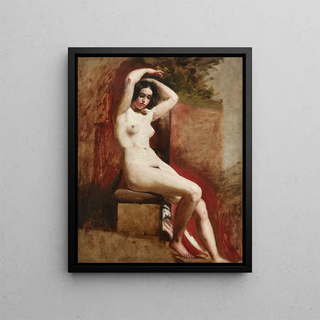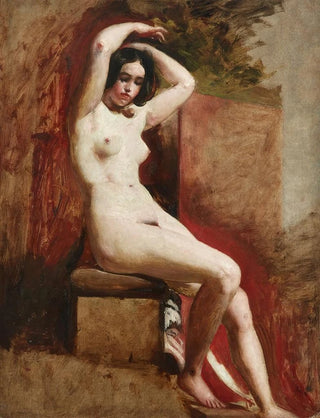Art print | Academic nude seated - William Etty


View from behind

Frame (optional)
In the world of art, some works transcend the simple frame of the canvas to become symbols of the aesthetics and culture of their era. "Nu académique assis" by William Etty is one of those creations that captivate the mind and awaken the senses. Painted in the 19th century, this painting embodies not only the beauty of the human body but also the artistic and moral debates that traversed Victorian society. By delving into this piece, one discovers a dialogue between classicism and romanticism, an exploration of sensuality and pure beauty, which continues to fascinate art enthusiasts today.
Style and uniqueness of the work
William Etty's style is characterized by a bold approach to the depiction of the nude. In "Nu académique assis," the artist uses a palette of warm, rich colors that give his subject remarkable life and dynamism. The light, skillfully manipulated, caresses the contours of the body, revealing the texture of the skin and emphasizing the voluptuous forms of the model. Every brushstroke seems to be a celebration of flesh, an ode to feminine beauty that defies the conventions of its time. Etty does not merely reproduce reality; he interprets it with a sensitivity that sets him apart from his contemporaries. His ability to capture emotion and grace in the movement of the human body makes this work an unforgettable masterpiece.
The artist and his influence
William Etty, born in York in 1787, is often regarded as one of the pioneers of the art print in the British context. His training at the Royal Academy of Arts in London and his travels across Europe allowed him to absorb influences from the great masters while developing his own style. Etty navigated between the expectations of Victorian society and his desire to represent beauty in all its forms. His work paved the way for a new appreciation of the art print in art, inspiring other artists to explore similar themes. Despite the criticisms he received, notably for the sensuality of his subjects, Etty left an indelible legacy that continues to inspire contemporary artists.
A wall decoration

Matte finish

View from behind

Frame (optional)
In the world of art, some works transcend the simple frame of the canvas to become symbols of the aesthetics and culture of their era. "Nu académique assis" by William Etty is one of those creations that captivate the mind and awaken the senses. Painted in the 19th century, this painting embodies not only the beauty of the human body but also the artistic and moral debates that traversed Victorian society. By delving into this piece, one discovers a dialogue between classicism and romanticism, an exploration of sensuality and pure beauty, which continues to fascinate art enthusiasts today.
Style and uniqueness of the work
William Etty's style is characterized by a bold approach to the depiction of the nude. In "Nu académique assis," the artist uses a palette of warm, rich colors that give his subject remarkable life and dynamism. The light, skillfully manipulated, caresses the contours of the body, revealing the texture of the skin and emphasizing the voluptuous forms of the model. Every brushstroke seems to be a celebration of flesh, an ode to feminine beauty that defies the conventions of its time. Etty does not merely reproduce reality; he interprets it with a sensitivity that sets him apart from his contemporaries. His ability to capture emotion and grace in the movement of the human body makes this work an unforgettable masterpiece.
The artist and his influence
William Etty, born in York in 1787, is often regarded as one of the pioneers of the art print in the British context. His training at the Royal Academy of Arts in London and his travels across Europe allowed him to absorb influences from the great masters while developing his own style. Etty navigated between the expectations of Victorian society and his desire to represent beauty in all its forms. His work paved the way for a new appreciation of the art print in art, inspiring other artists to explore similar themes. Despite the criticisms he received, notably for the sensuality of his subjects, Etty left an indelible legacy that continues to inspire contemporary artists.
A wall decoration






